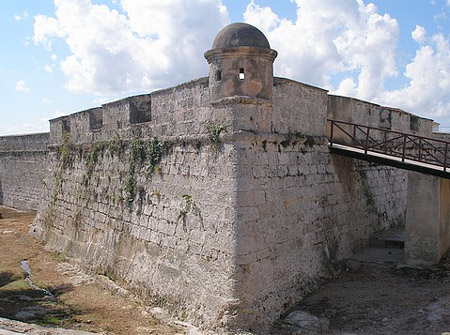 |
Castillo de San Severino
Matanzas, Cuba
|
|
 |
The name Matanzas means massacre, and refers to an incident in the 17th century. Spanish troops needed to get to an aboriginal village to kill everyone, but had to cross a river and possessed no boats. Local fishermen agreed to take the Spaniards across the water, but once the troops were in the middle of the river, the fishermen capsized the boats, which was the signal for an ambush to commence...and the Spanish troops were massacred. Get it?
|
 |
|
|
One assumes that this tragic event took place somewhere near the location at which the city of Matanzas was established, by Royal Spanish decree, in 1693. The city was founded to be populated by 30 families from the Canary Islands, but there must have been people already living there, since someone had been begging the Spanish crown for a fortification to protect the port from those dashing Corsairs, freebooters and/or pirates, for several years.
The Castillo de San Severino's first stone was laid on October 16, 1693. There appear to be at least three saints after whom the Castillo may have been named, but Severinus of Noricum (410-482), a Roman Catholic saint who lived in Italy (or maybe in Africa, which is frequently mistaken for Italy), seems the least unlikely of the three to have had a Spanish fort named after him.
|
 San Severino's moat was the full-of-water kind until 1910, when a road was built to its main gate. Since then, a dry moat has surrounded the fort. San Severino's moat was the full-of-water kind until 1910, when a road was built to its main gate. Since then, a dry moat has surrounded the fort. |
 |
Authorities ran out of money and workforce in 1697, and the Castillo sat, unfinished, for the next 34 years. In 1731 work was resumed under the direction of Spanish engineer Antonio Arredondo, and the fort was finally finished in 1745.
In 1756, Great Britain began actively gnawing on the Bourbon Monarchy, which put it (along with Portugal and Prussia, among others) in conflict with France and Spain (and Austria and Russia and Sweden (and others)). This became the Seven Years War (1756-1763), which would eventually lead to fighting just about everywhere any of these nations had colonies, which was...just about everywhere.
|
|
Cuba got to join the fun in June of 1762, when the British captured Havana. At the time, Havana had two starforts guarding the entrance to its harbor (one of which was San Salvador de la Punta), and if two starforts couldn't stop the British, reasoned Antonio Garcia Solis, the Castillo de San Severino's commanding officer, what chance did a single starfort have? Instead of finding out, Solis gave the order to destroy his Castillo, lest it fall into the hands of the unstoppable British. On August 14th, 1762, the Castillo of our current interest was "partially destroyed" by the loving application of black powder and fire. Either this strategic destruction worked, causing the wicked British to huffily seek undamaged starforts elsewhere, or else the British simply didn't give a crap about Matanzas or the Castillo, since they never bothered to go there.
|
In 1772, reconstruction of the fort commenced under the command of engineer Joaquin de Perazas. The Castillo was reconstructed enough in 1774 to begin service as Matanzas' Customs Office, a function that it fulfilled until 1793. As seems to be the case with a great many starforts, the Castillo was then used as a prison, from 1821 into the 1980's.
On April 23 1898, Spain declared war on the United States. Two days later the US Navy, practically rubbing its hands with glee, was bombarding Matanzas. This was the first action of the Spanish-American War, but doesn't seem to have resulted in much of anything, other than what one assumes were some broken buildings and/or injured Cubans.
|
 |
 Hallelujia. Hallelujia. |
|
Shortly after Matanzas' establishment, sugar plantations began to be developed in the area. A huge number of African slaves were brought in to work these plantations: By 1841, over 60% of Matanzas' population were slaves. Today, the Castillo de San Severino houses a small museum that tells the story of slavery in Cuba. The Castillo de San Severino was visited in 2009 by Marko, a Dutch gentleman who runs the very cool site Castles.nl. Marko reports that the Castillo can be visited for a small fee that magically becomes a rather large fee if the visitor wishes to use his or her camera. He goes on to say that most of the fort was off limits during his visit, making even the small fee too large. Thanks to Marko for his visit, and for the two pictures I've used on this page! |
|
|
|
|
|
 |




